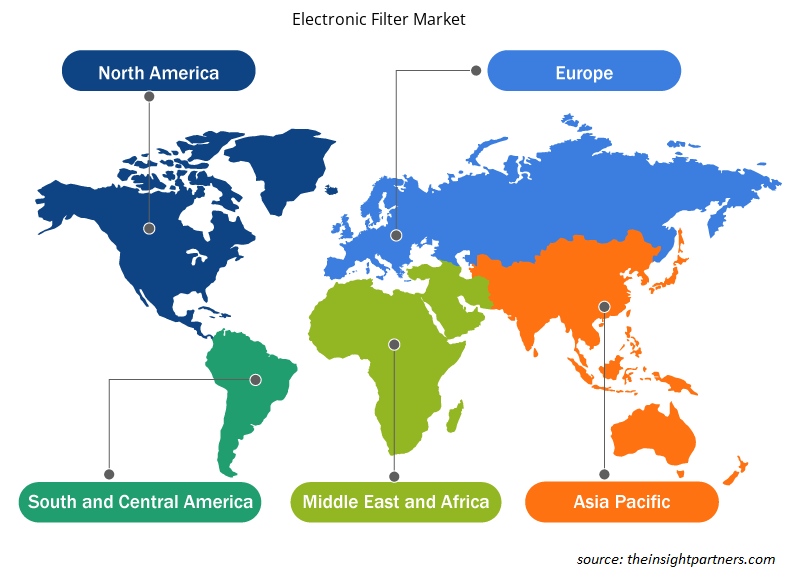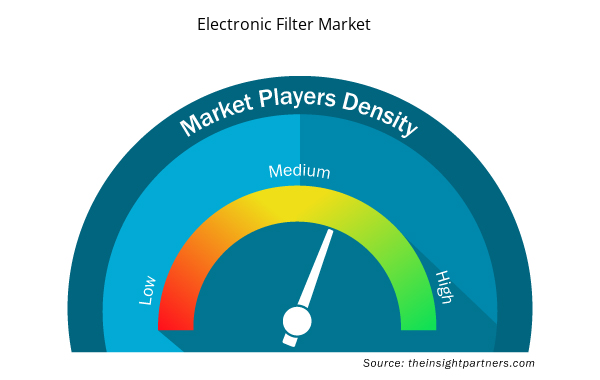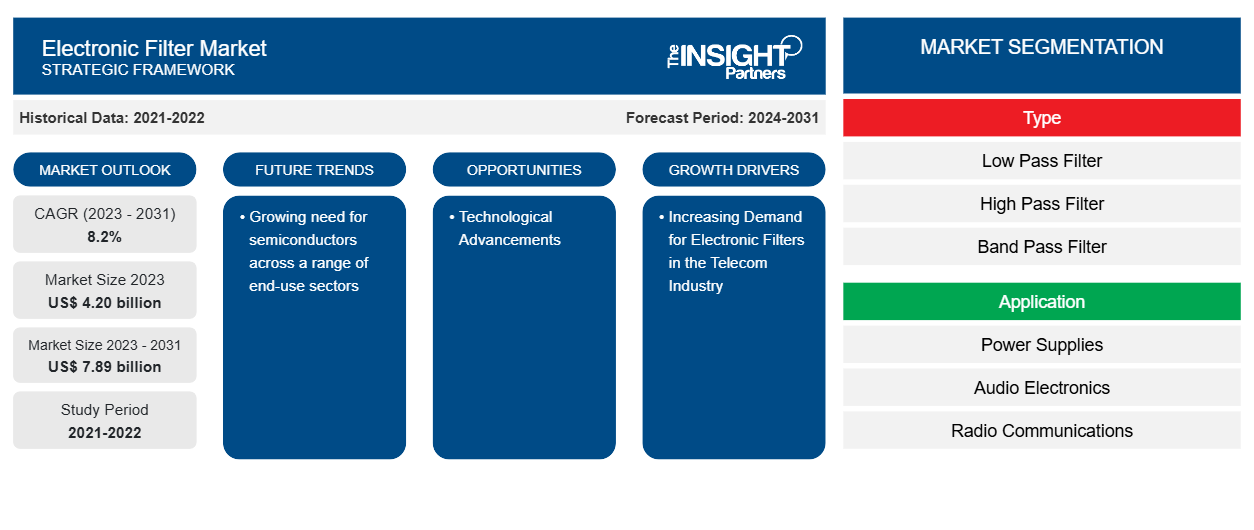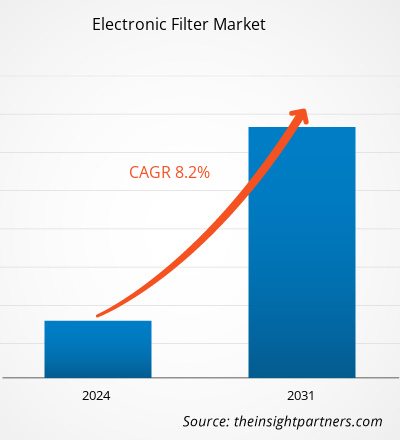Si prevede che la dimensione del mercato globale dei filtri elettronici crescerà da 4,20 miliardi di dollari nel 2023 a 7,89 miliardi di dollari entro il 2031; si prevede che si espanderà a un CAGR dell'8,2% dal 2023 al 2031. La crescente necessità di semiconduttori in una gamma di settori di utilizzo finale rimarrà probabilmente una delle principali tendenze del mercato dei filtri elettronici.
Analisi di mercato dei filtri elettronici
Il mercato dei filtri elettronici è guidato principalmente dalla crescente domanda di filtri elettronici nel settore delle telecomunicazioni. Inoltre, l'introduzione del 5G e il crescente utilizzo delle reti LTE , in particolare nelle nazioni emergenti, sono i principali motori dell'espansione del settore delle telecomunicazioni globali , contribuendo anche alla crescita del mercato dei filtri elettronici.
Panoramica del mercato dei filtri elettronici
Un filtro elettronico si riferisce a un circuito o dispositivo che viene utilizzato per modificare, rimodellare o rifiutare frequenze specifiche in un segnale elettrico, consentendo il passaggio delle frequenze desiderate. I filtri sono ampiamente utilizzati in vari settori, tra cui alimentatori, elettronica audio, comunicazioni radio e sistemi di elaborazione di segnali e immagini. Esistono diversi tipi di filtri, tra cui filtri passa-basso, passa-alto, passa-banda e notch. I filtri hanno varie applicazioni negli alimentatori, nell'elettronica audio, nelle comunicazioni radio e nei sistemi di elaborazione di segnali e immagini. Possono essere classificati come passivi o attivi, a seconda dei componenti utilizzati nella loro costruzione.
Personalizza questo report in base alle tue esigenze
Riceverai la personalizzazione gratuita di qualsiasi report, comprese parti di questo report, o analisi a livello nazionale, pacchetto dati Excel, oltre a usufruire di grandi offerte e sconti per start-up e università
- Scopri le principali tendenze di mercato in questo rapporto.Questo campione GRATUITO includerà analisi di dati che spaziano dalle tendenze di mercato alle stime e alle previsioni.
Driver e opportunità del mercato dei filtri elettronici
La crescente domanda di filtri elettronici nel settore delle telecomunicazioni favorisce il mercato
Il settore delle telecomunicazioni sta gradualmente cambiando a causa dell'ambiente tecnologico in continua evoluzione e del crescente utilizzo di smartphone e altri dispositivi connessi in tutto il mondo. Inoltre, l'introduzione del 5G e il crescente utilizzo delle reti LTE , in particolare nelle nazioni emergenti, sono i principali motori dell'espansione del settore delle telecomunicazioni globali. La necessità di filtri elettronici nel settore delle telecomunicazioni mondiale è guidata dalla forte previsione di crescita del settore, che è il risultato dell'espansione della penetrazione della rete e della domanda dei clienti di contenuti digitali.
Progressi tecnologici
Oggigiorno, i filtri elettronici vengono uniti ad altre tecnologie all'avanguardia come la robotica, l'apprendimento automatico e l'intelligenza artificiale (IA). Questa connessione consente un'automazione migliorata e una maggiore funzionalità in una vasta gamma di applicazioni. I filtri basati sull'intelligenza artificiale, ad esempio, sono in grado di analizzare intricati modelli di dati e di adattarli in tempo reale per massimizzare l'efficienza.
Analisi della segmentazione del rapporto di mercato dei filtri elettronici
Segmenti chiave che hanno contribuito alla derivazione dell'analisi del mercato dei filtri elettronici: tipologia e applicazione.
- In base al tipo, il mercato è suddiviso in filtro passa-basso, filtro passa-alto, filtro passa-banda, filtro blocca-banda e filtro passa-tutto. Il segmento del filtro passa-basso ha detenuto una quota di mercato maggiore nel 2023.
- In base all'applicazione, il mercato è suddiviso in alimentatori, elettronica audio , comunicazioni radio e conversione da analogia a digitale. Il segmento dell'elettronica audio ha detenuto una quota di mercato maggiore nel 2023.
Analisi della quota di mercato dei filtri elettronici per area geografica
L'ambito geografico del rapporto sul mercato dei filtri elettronici è suddiviso principalmente in cinque regioni: Nord America, Asia Pacifico, Europa, Medio Oriente e Africa e Sud America/Sud e Centro America. Il Nord America ha dominato il mercato dei filtri elettronici nel 2023. Uno dei principali fattori che spingono il mercato dei filtri elettronici è la prognosi ottimistica di sviluppo del settore delle telecomunicazioni in Nord America. Il mercato si sta espandendo a seguito della crescente necessità di filtri elettronici da parte del settore delle telecomunicazioni.
Approfondimenti regionali sul mercato dei filtri elettronici
Le tendenze regionali e i fattori che influenzano il mercato dei filtri elettronici durante il periodo di previsione sono stati ampiamente spiegati dagli analisti di Insight Partners. Questa sezione discute anche i segmenti e la geografia del mercato dei filtri elettronici in Nord America, Europa, Asia Pacifico, Medio Oriente e Africa e Sud e Centro America.

- Ottieni i dati specifici regionali per il mercato dei filtri elettronici
Ambito del rapporto sul mercato dei filtri elettronici
| Attributo del report | Dettagli |
|---|---|
| Dimensioni del mercato nel 2023 | 4,20 miliardi di dollari USA |
| Dimensioni del mercato entro il 2031 | 7,89 miliardi di dollari USA |
| CAGR globale (2023-2031) | 8,2% |
| Dati storici | 2021-2022 |
| Periodo di previsione | 2024-2031 |
| Segmenti coperti | Per tipo
|
| Regioni e Paesi coperti | America del Nord
|
| Leader di mercato e profili aziendali chiave |
|
Densità degli attori del mercato dei filtri elettronici: comprendere il suo impatto sulle dinamiche aziendali
Il mercato dei filtri elettronici sta crescendo rapidamente, spinto dalla crescente domanda degli utenti finali dovuta a fattori quali l'evoluzione delle preferenze dei consumatori, i progressi tecnologici e una maggiore consapevolezza dei vantaggi del prodotto. Con l'aumento della domanda, le aziende stanno ampliando le loro offerte, innovando per soddisfare le esigenze dei consumatori e capitalizzando sulle tendenze emergenti, il che alimenta ulteriormente la crescita del mercato.
La densità degli operatori di mercato si riferisce alla distribuzione di aziende o società che operano in un particolare mercato o settore. Indica quanti concorrenti (operatori di mercato) sono presenti in un dato spazio di mercato in relazione alle sue dimensioni o al valore di mercato totale.
Le principali aziende che operano nel mercato dei filtri elettronici sono:
- ABB Ltd.
- Società AVX
- BLOCK Transformatoren-Elektronik GmbH
- Società di cattura
- Anritsu
- Azienda
Disclaimer : le aziende elencate sopra non sono classificate secondo un ordine particolare.

- Ottieni una panoramica dei principali attori del mercato dei filtri elettronici
Notizie e sviluppi recenti sul mercato dei filtri elettronici
Il mercato dei filtri elettronici viene valutato raccogliendo dati qualitativi e quantitativi post-ricerca primaria e secondaria, che includono importanti pubblicazioni aziendali, dati associativi e database. Di seguito è riportato un elenco degli sviluppi nel mercato:
- A febbraio 2024, ABB India lancia il suo azionamento compatto di nuova generazione, ACH180, per apparecchiature HVACR (riscaldamento, ventilazione, condizionamento dell'aria e refrigerazione). Come ultima aggiunta al portafoglio di azionamenti HVACR di ABB, ACH180 consente un controllo esperto di motori ad alta efficienza, utilizzando al contempo un design compatto per risparmiare spazio, ridurre le spese in conto capitale e semplificare la messa in servizio. Con un filtro integrato per ridurre le emissioni ad alta frequenza, consente di utilizzare l'azionamento in ambienti industriali o domestici senza la necessità di acquistare e installare filtri esterni aggiuntivi.
(Fonte: ABB, Comunicato stampa, 2024)
Copertura e risultati del rapporto sul mercato dei filtri elettronici
Il rapporto "Dimensioni e previsioni del mercato dei filtri elettronici (2021-2031)" fornisce un'analisi dettagliata del mercato che copre le seguenti aree:
- Dimensioni e previsioni del mercato a livello globale, regionale e nazionale per tutti i segmenti di mercato chiave coperti dall'ambito
- Dinamiche di mercato come fattori trainanti, vincoli e opportunità chiave
- Principali tendenze future
- Analisi dettagliata delle cinque forze PEST/Porter e SWOT
- Analisi di mercato globale e regionale che copre le principali tendenze di mercato, i principali attori, le normative e gli sviluppi recenti del mercato
- Analisi del panorama industriale e della concorrenza che copre la concentrazione del mercato, l'analisi della mappa di calore, i principali attori e gli sviluppi recenti
- Profili aziendali dettagliati
- Analisi storica (2 anni), anno base, previsione (7 anni) con CAGR
- Analisi PEST e SWOT
- Valore/volume delle dimensioni del mercato - Globale, regionale, nazionale
- Industria e panorama competitivo
- Set di dati Excel



Report Coverage
Revenue forecast, Company Analysis, Industry landscape, Growth factors, and Trends

Segment Covered
This text is related
to segments covered.

Regional Scope
North America, Europe, Asia Pacific, Middle East & Africa, South & Central America

Country Scope
This text is related
to country scope.
Domande frequenti
The electronic filter market size is expected to grow from US$ 4.20 billion in 2023 to US$ 7.89 billion by 2031; it is anticipated to expand at a CAGR of 8.2% from 2024 to 2031.
The market for electronic filters is mostly driven by increasing demand for electronic filters in the telecom industry.
The growing need for semiconductors across a range of end-use sectors is likely to remain key electronic filter market trends.
The key players holding the majority of shares in global electronic filters are ABB Ltd., AVX Corporation, BLOCK Transformatoren-Elektronik GmbH, Captor Corporation, and Anritsu.
The global electronic filter market is expected to reach US$ 7.89 billion by 2031.
Trends and growth analysis reports related to Electronics and Semiconductor : READ MORE..
The Insight Partners performs research in 4 major stages: Data Collection & Secondary Research, Primary Research, Data Analysis and Data Triangulation & Final Review.
- Data Collection and Secondary Research:
As a market research and consulting firm operating from a decade, we have published and advised several client across the globe. First step for any study will start with an assessment of currently available data and insights from existing reports. Further, historical and current market information is collected from Investor Presentations, Annual Reports, SEC Filings, etc., and other information related to company’s performance and market positioning are gathered from Paid Databases (Factiva, Hoovers, and Reuters) and various other publications available in public domain.
Several associations trade associates, technical forums, institutes, societies and organization are accessed to gain technical as well as market related insights through their publications such as research papers, blogs and press releases related to the studies are referred to get cues about the market. Further, white papers, journals, magazines, and other news articles published in last 3 years are scrutinized and analyzed to understand the current market trends.
- Primary Research:
The primarily interview analysis comprise of data obtained from industry participants interview and answers to survey questions gathered by in-house primary team.
For primary research, interviews are conducted with industry experts/CEOs/Marketing Managers/VPs/Subject Matter Experts from both demand and supply side to get a 360-degree view of the market. The primary team conducts several interviews based on the complexity of the markets to understand the various market trends and dynamics which makes research more credible and precise.
A typical research interview fulfils the following functions:
- Provides first-hand information on the market size, market trends, growth trends, competitive landscape, and outlook
- Validates and strengthens in-house secondary research findings
- Develops the analysis team’s expertise and market understanding
Primary research involves email interactions and telephone interviews for each market, category, segment, and sub-segment across geographies. The participants who typically take part in such a process include, but are not limited to:
- Industry participants: VPs, business development managers, market intelligence managers and national sales managers
- Outside experts: Valuation experts, research analysts and key opinion leaders specializing in the electronics and semiconductor industry.
Below is the breakup of our primary respondents by company, designation, and region:

Once we receive the confirmation from primary research sources or primary respondents, we finalize the base year market estimation and forecast the data as per the macroeconomic and microeconomic factors assessed during data collection.
- Data Analysis:
Once data is validated through both secondary as well as primary respondents, we finalize the market estimations by hypothesis formulation and factor analysis at regional and country level.
- Macro-Economic Factor Analysis:
We analyse macroeconomic indicators such the gross domestic product (GDP), increase in the demand for goods and services across industries, technological advancement, regional economic growth, governmental policies, the influence of COVID-19, PEST analysis, and other aspects. This analysis aids in setting benchmarks for various nations/regions and approximating market splits. Additionally, the general trend of the aforementioned components aid in determining the market's development possibilities.
- Country Level Data:
Various factors that are especially aligned to the country are taken into account to determine the market size for a certain area and country, including the presence of vendors, such as headquarters and offices, the country's GDP, demand patterns, and industry growth. To comprehend the market dynamics for the nation, a number of growth variables, inhibitors, application areas, and current market trends are researched. The aforementioned elements aid in determining the country's overall market's growth potential.
- Company Profile:
The “Table of Contents” is formulated by listing and analyzing more than 25 - 30 companies operating in the market ecosystem across geographies. However, we profile only 10 companies as a standard practice in our syndicate reports. These 10 companies comprise leading, emerging, and regional players. Nonetheless, our analysis is not restricted to the 10 listed companies, we also analyze other companies present in the market to develop a holistic view and understand the prevailing trends. The “Company Profiles” section in the report covers key facts, business description, products & services, financial information, SWOT analysis, and key developments. The financial information presented is extracted from the annual reports and official documents of the publicly listed companies. Upon collecting the information for the sections of respective companies, we verify them via various primary sources and then compile the data in respective company profiles. The company level information helps us in deriving the base number as well as in forecasting the market size.
- Developing Base Number:
Aggregation of sales statistics (2020-2022) and macro-economic factor, and other secondary and primary research insights are utilized to arrive at base number and related market shares for 2022. The data gaps are identified in this step and relevant market data is analyzed, collected from paid primary interviews or databases. On finalizing the base year market size, forecasts are developed on the basis of macro-economic, industry and market growth factors and company level analysis.
- Data Triangulation and Final Review:
The market findings and base year market size calculations are validated from supply as well as demand side. Demand side validations are based on macro-economic factor analysis and benchmarks for respective regions and countries. In case of supply side validations, revenues of major companies are estimated (in case not available) based on industry benchmark, approximate number of employees, product portfolio, and primary interviews revenues are gathered. Further revenue from target product/service segment is assessed to avoid overshooting of market statistics. In case of heavy deviations between supply and demand side values, all thes steps are repeated to achieve synchronization.
We follow an iterative model, wherein we share our research findings with Subject Matter Experts (SME’s) and Key Opinion Leaders (KOLs) until consensus view of the market is not formulated – this model negates any drastic deviation in the opinions of experts. Only validated and universally acceptable research findings are quoted in our reports.
We have important check points that we use to validate our research findings – which we call – data triangulation, where we validate the information, we generate from secondary sources with primary interviews and then we re-validate with our internal data bases and Subject matter experts. This comprehensive model enables us to deliver high quality, reliable data in shortest possible time.


 Ottieni un campione gratuito per questo repot
Ottieni un campione gratuito per questo repot